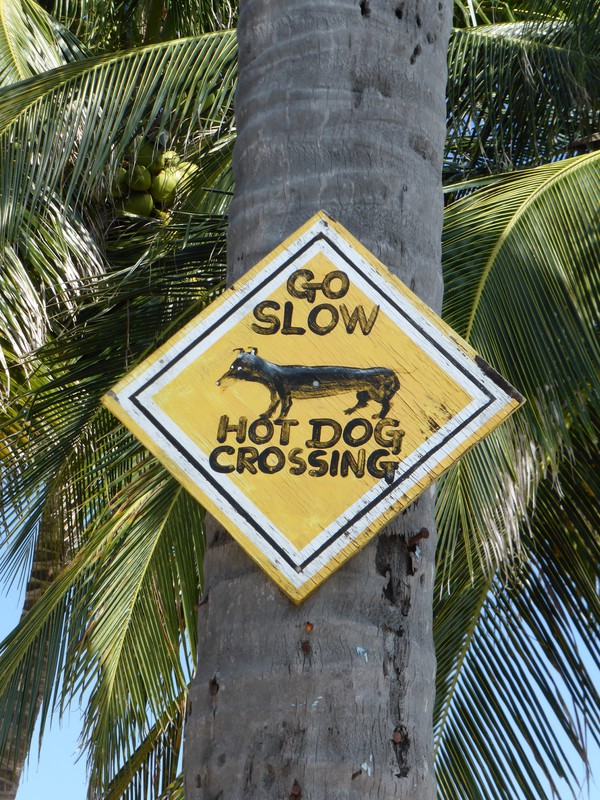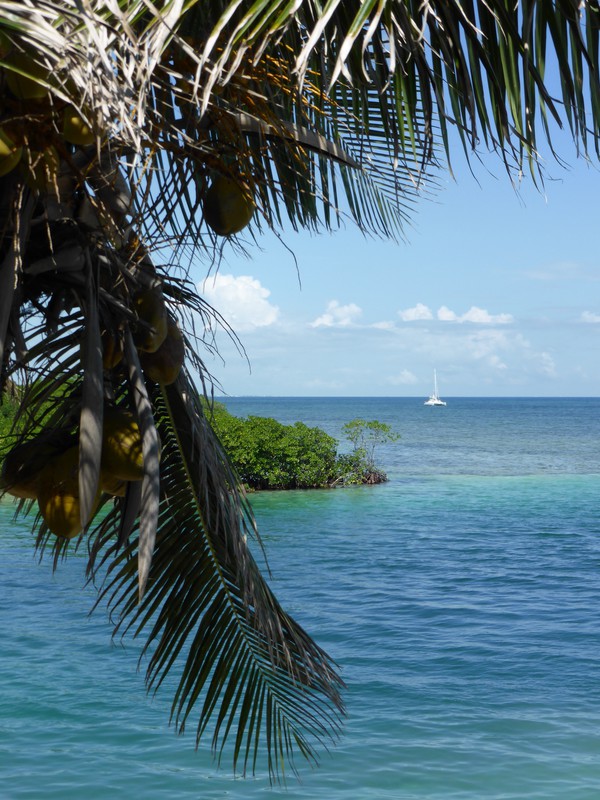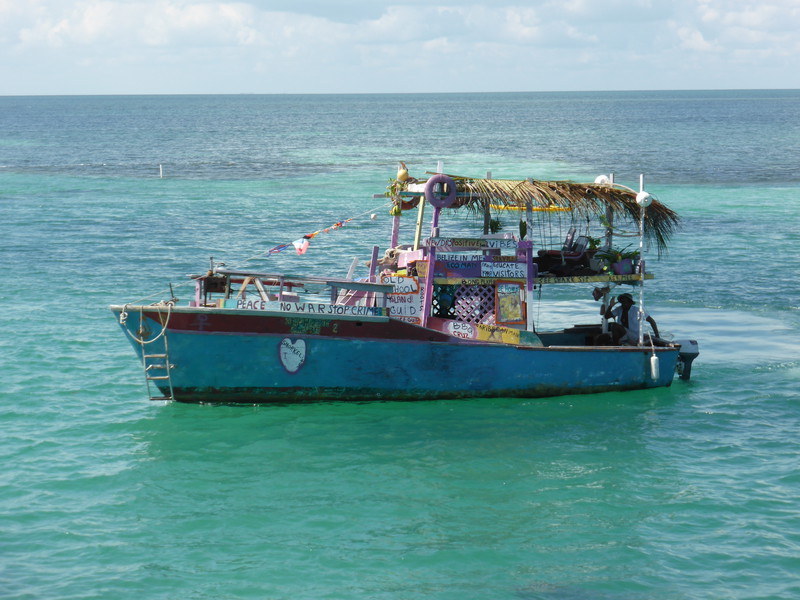
The unofficial motto of Caye Caulker, one of the many small, sandy islands off the north coast of Belize, is 'Go Slow', and it's obvious from the moment you step off the ferry that this little corner of the Caribbean Sea dances to its own relaxed rhythm. The traffic here is all about golf buggies, bicycles and pedestrians, rather than cars, lorries and buses, and there are no traffic jams to speak of; the Rastas that look after the handful of trinket stalls along the northern beach are so laid back that their sales pitches are hard to tell from genuine greetings; and even the nightlife winds down at a civilised hour, so the nights are refreshingly quiet under the starry skies of the tropical moon. Caye Caulker is, without a doubt, a little slice of paradise, managing to retain a charm that its busier and more popular neighbour, Ambergris Caye, is in danger of losing with its busier roads and larger hotels.

People come to Caye Caulker to kick back, and after the long journey from Mexico, that's exactly what we did. The torrential rain that we'd dragged ourselves through on arrival soon subsided, and although most days we still saw the odd sharp downpour, the sun came out in style, drying out our mouldy clothes and blowing a fresh, dry breeze through our hair. While Mexico seems to be full of claustrophobic buildings with rising damp, black mould and worryingly dank smells, Caye Caulker's buildings are light and airy, and even though it rains here with the same biblical determination as the rest of the region, the architecture is built to cope. The roofs over the wooden verandas don't leak, in stark contrast to the leaky restaurant in Tulum; the sea breezes soon blow away any mustiness from the well-ventilated rooms, unlike the heavy dampness of the hemmed-in hotels of Playa del Carmen; and, more importantly, the insides of the buildings are lit up by the sunny smiles of the locals, which prevents the rot setting in.
In short, in Caye Caulker it's a pleasure to be in the tropics, which is something I never felt in steamy Mexico.
Paradise Found

Caye Caulker is a tiny sand island, perched on top of a reef. This kind of island is called a caye (pronounced 'key'), and most cayes are fairly small; Caye Caulker is one of the smallest, at only five miles long and a mile wide. The island is split in two by a water channel called the Split, which the islanders dug out after the storm surge from the 1961 Hurricane Hattie cut across the island and created a small breach. The Split is now a wide channel that cuts across the island from east to west: north of the Split the island is almost uninhabited and is smothered in mangroves and forest, though parcels of land are currently up for sale in the windows of the local estate agents, so you can expect the northern half to change rapidly in the coming years; meanwhile the southern half is home to the island's main settlement, which consists of three parallel roads – known as Front Street, Middle Street and Back Street, though they do have more formal names that nobody seems to use – each of them lined with relaxed restaurants, small shops, diving and snorkelling operations, and locals cycling gently along the streets, saying hello to each other in lilting Caribbean accents as they gently weave left and right to avoid the dips in the road where the puddles form after the rains. The language here is English, but even if you didn't understand a word – which is quite often the case, as the English spoken here is as much Creole as it is Commonwealth – you'd still know that the vibe was relaxed; it's all in the intonation.

We happily settled in to a routine of leisurely breakfasts, relaxing days and long evenings. Not much happens in Caye Caulker, which is the point; for excitement there are diving trips to the reefs off the island and nearby Ambergris Caye, as well as the famous Great Blue Hole of Belize, further out in the Caribbean. But on Caulker itself the busiest spot is the bar at the Split, where travellers congregate to sunbathe and drink Belikin beer and cocktails on a boardwalk by the water, while Jay-Z pumps out of the speakers (back in the 1980s and 1990s, the international languages of travel were Bob Marley and football, but now hip-hop seems to have taken on the soundtrack duties, while football continues its reign as the world's cultural Esperanto). As lunchtime approaches, locals set up oil-drum barbecues along the northern beach, where they cook chicken, lobster, fish and conch, sending mouthwatering smells down the road to pull in the unwary; and as the afternoon siesta drifts into the early evening, people head out into the town, such as it is, to check out the restaurants. As if in answer to our prayers, some of them even display the catch of the day outside – wiggling lobsters and clear-eyed snapper, all of them ready to jump straight onto the barbecue – and you simply pick the size of fish or crustacean that you fancy, and sit back with a Belizean beer while the smell of your dinner wafts enticingly on the sea breeze.

Even the beer in Belize is delightfully simple. The main brewer is Belikin, and their main brews are standard Belikin beer at 4.8%, and Belikin stout at 6.5%; these two use the same bottle, so you can only tell your poison by holding the bottle up to the light and looking at the colour of the contents. They also do a light beer called Lighthouse and a maltier premium beer, but for me, the light and dark, as they're known, tick all the boxes: light for thirst, and dark for the kick. I love stout in hot countries – I got a taste for it in Ghana – and Belize has got it sorted.
And don't forget the cake lady, who sells delightful homemade cakes from her hand-pulled cart every afternoon along the seafront; or the fruit stalls with perfect bananas and succulent pineapples; or the fresh fruit juice stalls, or the bakery in Middle Street, or the amazing 'fry jacks', light profiterole-like fried dough pockets that are a marriage made in breakfast heaven when combined with pureed beans and habanero sauce, or with jam and butter for a sweeter kick. After the stodgy and fibre-deficient food of the Yucatán, Belizean fare is pure paradise.
Paradise Lost

There is, though, a slight crack in the façade, and every now and then real life spills through. Pretty much every day, we saw someone somewhere lose it. One night we had a Rasta lying on the beach outside our window, smashed out of his brains on weed and local rum, calling out bizarre non-sequitur obscenities into the night before passing out in a haze of red, rolling eyes; another night one of the Chinese men from the local supermarket made a phone call in the middle of the street in which he completely lost it and shouted piercingly scary Chinese threats into the handset for a good ten minutes, while his business partner tried to coax him away from the red mist and back to sanity; another night one of the other shopkeepers had a stand-up row with a sloppily dressed local whom he'd kicked out of the shop, following it up with, 'Come back here now you coward and let's sort out this man to man, you fucking scum, you don't come round here no more, I sort you out good and proper'; and then there was the black guy shouting, 'I'm not racialist or anything, but it's like you're a monkey and I'm a gorilla.' It's like lying under a picture-perfect palm tree and hearing the faint creaks and rustles from the fronds above that indicate a coconut might fall down at any minute, breaking the tension and possibly someone's face, too.

And peppered around this background noise of locals losing their cool with each other, there are noisy gaggles of Australian girls peddling the late-night streets with their astonishingly piercing shrieks; there are monged-out twenty-somethings from Oregon at the food stalls who make you realise that no, South Park isn't a satirical show, it's a documentary; and there are plenty of slightly lost travellers wandering around, like the young English guy who cornered us in the ATM and grilled us in a panicky voice about the best approach to changing money at the Guatemalan border ('I don't know, can't you see I'm using the bloody cash machine?' was my gruff response, as the ATM booth is neither the time nor the place to corner other people, unless you're a thief). Caye Caulker is a classic stop on the Gringo Trail, the classic travellers' route that stretches from Mexico to Panama, and at times you can feel you're stuck in gap year hell; still, the next step along the road for Caulker is a full-blown tourist industry, and the Gringo Trail is a minor fate compared to that...
But despite these cracks around the edges, the charms of the Caribbean win out every time, and Caye Caulker is, for now, a little bit of paradise. One hopes that for this part of the world, everything continues to go slow, including the inevitable change into a more popular and less charming destination. Enjoy it while you can, because this won't be a quiet corner for long.